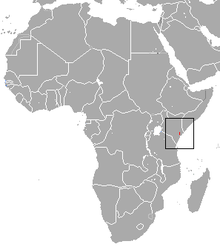Sanje crested mangabey
| Tana River mangabey | |
|---|---|
| Scientific classification | |
| Kingdom: | Animalia |
| Phylum: | Chordata |
| Class: | Mammalia |
| Order: | Primates |
| Suborder: | Haplorhini |
| Family: | Cercopithecidae |
| Genus: | Cercocebus |
| Species: | C. galeritus |
| Binomial name | |
|
Cercocebus galeritus Peters, 1879 |
|
 |
|
| Tana River mangabey range | |
The Tana River mangabey (Cercocebus galeritus) is a highly endangered species of primate in the family Cercopithecidae. Some authorities have included the taxa agilis and sanjei as subspecies of this species, while others award these full species status.
It is endemic to riverine forest patches along the lower Tana River in southeastern Kenya. It is threatened by habitat loss and degradation, which has increased in recent years. This species was, together with the equally endangered Tana River red colobus, the main reason for the creation of the Tana River Primate Reserve in 1978, but human encroachment within this reserve continues. Recently, it has been suggested that 20,000 hectares of the Tana River Delta should be transformed into sugarcane plantations, but this has, temporarily at least, been stopped by the High Court of Kenya.
The Tana River mangabey is a medium-sized primate with a long semi-prehensile tail, yellow-brown coat, and a center part on the crown of the head with long, dark fur. The species has white eyelids that contrast to its darker face like other Cercocebus species. This contrast in the eyelids is believed to be used as part of the species complex communication system. The species also has specialized dental morphology for feeding on hard nuts, seeds, and fruits.
The Tana River mangabey is diurnal and semi-terrestrial. It spends most of its time on the ground but is still considered arboreal due to its sleeping area. The species sleeps in trees which are approximately 27-37m in height which have a sparse canopy cover of 25–60%. The primate sleeps in the forks of the branches of these trees or near the main trunk. It is believed to sleep in trees to reduce the risk of predation and chooses this site according to its last feeding position in the area.
...
Wikipedia

